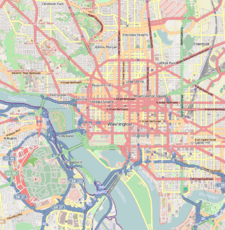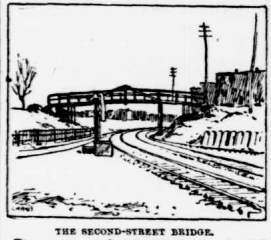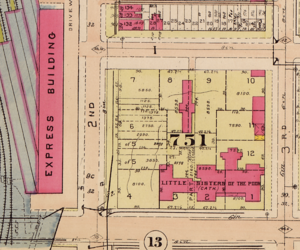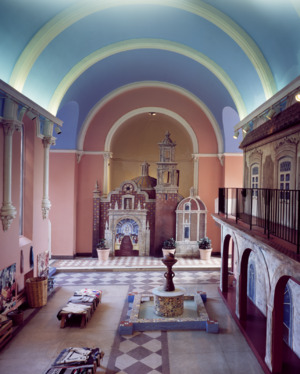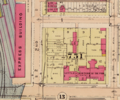Home for the Aged Men and Women (Washington, DC) facts for kids
Quick facts for kids Home for the Aged Men and Women |
|
|---|---|
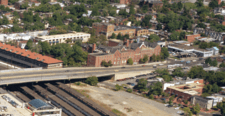
Detail of an Aerial view of Union Station showing the former Home for the Aged Men and Women in the 1980s
|
|
| Geography | |
| Location | Washington, DC, United States |
| Coordinates | 38°54′01″N 77°00′09″W / 38.90028°N 77.00250°W |
| Services | |
| Beds | 300 |
| History | |
| Founded | March 19th 1873 |
| Closed | March 1977 |
The Home for the Aged Men and Women was a special place in Washington, D.C.. It was also known as the Home for the Aged, Poor and Infants. This charitable organization was located on H Street NE. It was near the train tracks in a working-class area called Swampoodle.
The Home was run by the Little Sisters of the Poor. These Sisters provided a safe place to live, food, and care for elderly men and women. They helped anyone over 65 years old who had no family to care for them. They helped people regardless of their religion or race. The Sisters would often ask for donations to support the Home and its residents.
The Home opened on March 19, 1873. It grew throughout the late 1800s. It became a vital place for many older people who needed help. Each year, on Saint Joseph's Day, important people from Washington, D.C., would visit the Home. The building survived the 1968 riots. However, it was affected by big city changes in the 1970s. Today, the site is a modern apartment complex.
Contents
History of the Home for the Aged
After the Civil War, the Northeast part of Washington, D.C. was still quite rural. A neighborhood called Swampoodle grew near the railroad tracks. These tracks ran from the New Jersey Avenue Station near the Capitol up to Baltimore. The Little Sisters of the Poor bought land in this new area. This land was once owned by Thomas Law. He had married the step-granddaughter of George Washington.
Building the First Home
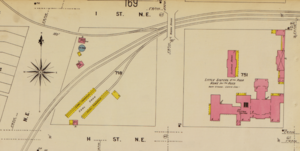
The first stone of the building was placed on July 23, 1872. This happened on H Street NE between 2nd and 3rd Street NE. Groups like the Knights of Saint Patrick were there. While building, the Sisters stayed near Saint Patrick's Church. They moved into their new Home on March 19, 1873. This date was special because it was Saint Joseph's Day, their patron saint. Archbishop Bayley visited the Home soon after it opened.
The Home received money from private donations. It also got funds from special events. For example, a concert was held at the Masonic Temple in May 1873. The Diplomatic Corps organized it, and the Marine Band played. All the money went to the Home. The District of Columbia also gave $750 to the Home.
By April 1874, about sixty people lived at the Home. The building was full, and more space was needed. The organization was in debt, but they planned to add a new section once the debt was paid.
Adding the Chapel
The Sisters received $25,000 from the District of Columbia in June 1874. That same year, they started building a new chapel. Archbishop Bayley helped lay the first stone on October 18, 1874. The Chapel was planned to be 24 feet by 60 feet. It would connect to the main building. The main building would be four stories high and house 100 residents. The architect was E.F. Baldwin.
In 1874, the Sisters also gained more land. They received lots 9, 10, 11, 12, 1, and 2 on their block. The Great Falls Ice Company also decided to give free ice to the Home.
The Chapel was officially opened on November 14, 1875. Archbishop Bayley led the ceremony. The inside of the chapel was simple and white. It had a small balcony for singers. There was a statue of the Virgin Mary above the main altar. Figures of Christ were over the side altars. Many flowers decorated the chapel for the special day.
Growing the Home
Even though the Home was large, it couldn't help everyone who needed it. It had grown quickly, but the costs were high. In December 1875, a report showed the property's value. The land cost $12,000. The wing and stable cost $20,000. The main building also cost $20,000. At this time, 80 people lived at the Home.
The Sisters worked to make the Home more comfortable. In 1876, they got permission to build a smoking room for residents. In 1878, they got a permit for a carriage house.
A new wing was planned to house more people. Construction started in September 1879. This new section would match the existing east wing. It would be 86 feet long, 32 feet wide, and four stories high. It was made of red brick with brownstone trim. It had fifteen large rooms with good light and air. Each floor had a long, open hall.
- Basement: Laundry room, furnace room, and storage.
- First floor: Men's sitting room and shops.
- Second floor: Sitting room for those who were sick, a dormitory, and a pharmacy.
- Third floor: Two large rooms.
- Attic: Two more rooms.
Congress gave $5,000 to help with the construction in 1880. In 1882, Congress allowed the closing of an alley on the Home's property.
Serving the Community
By this time, the Home was a big part of the community. It could care for 200 residents. By May 1882, 150 people lived there. It was clear this important work would continue. In 1881, three Sisters began the process to become United States citizens.
Until 1882, the Home only housed White residents. In 1882, it opened a section for Black residents. By 1883, 28 Black residents lived there.
More Expansion and Support
In 1884, the Sisters received another $25,000 from Congress. This money was for building another large wing.
On November 6, 1884, more land lots were given to the Sisters.
Special Events and Challenges
On May 1, 1885, the Sisters received special permission. They were allowed to ask for donations from employees at the United States Department of the Interior. Two Sisters stood at the entrance with a basket to collect money.
Sometimes, asking for money in public caused problems. In November 1889, two Sisters were collecting donations at the Pension Building. This was where government clerks got their paychecks. However, General Raum, a government official, said this was not allowed in a public building. He felt it was unfair to other charities. He continued to donate monthly himself.
On December 21, 1893, Congress closed the remaining alleys on the Home's property. This helped the Sisters own the entire block.
By 1900, the Home had 300 residents. Life continued much the same for many years. In June 1911, a storm badly damaged the west wall of the building.
In October 1939, the Sisters celebrated their Order's 100th Anniversary. There were three days of celebrations. Many important Catholic Church leaders attended.
On March 28, 1954, the Mother General of the Order visited the Home for the first time. Mother Genevieve St. Chantal from France thanked everyone who had donated over the years.
Moving to a New Home
In 1977, the Sisters announced they were moving. The area had been damaged by the 1968 Riots. Many shops on H Street were burned. However, the main reason for the move was the building of the Hopscotch Bridge. This concrete bridge connected H Street NW to H Street NE over the Union Station rail tracks.
When the bridge construction started in 1975, the Home's walls and floors began to shift. Bathroom tiles fell, and cracks appeared. Paint peeled from the walls because of vibrations. Rocks flew into windows, and there were problems with vandalism. The bridge was built so close that the Chapel's main entrance had to be closed. In 1977, the Sisters moved with their 118 residents.
On December 1, 1977, the Sisters received an award for their service. After 106 years, they felt the local government was pushing them out. The Sisters began raising money for a new house. They raised $1.3 million, but the new home was expected to cost $4.5 million. On June 2, 1978, they bought a new building for their Home.
A New Chapter for the Building
The old Home building became the National Children's Museum from 1979 to 2004. On January 22, 1990, First Lady Barbara Bush visited the museum. She read to children as part of her Foundation for Family Literacy. In 2005, a developer bought the building. It was turned into a luxury apartment complex called Senate Square. Former Mayor Anthony A. Williams was one of the first people to live there.
Daily Life at the Home
In 1886, a newspaper called The Evening Star visited the Home. They wrote a detailed description of life there. The Sister Superior explained how the Sisters would go door-to-door. They asked for money, food, or anything people could give. She said, "It is from the working people, the poorer people, we get most. They always have ten cents for us or a loaf of bread." The Sisters never planned for more than one day at a time. They relied on good people's kindness.
The Home was very clean and tidy. It housed 200 residents. The dormitories had cots with soft feather beds. They were covered with white counterpanes and homemade quilts. These quilts were made by some of the residents. The dormitories were locked during the day. This was to make sure residents didn't just go to bed if they felt unwell. If someone needed to rest, a Sister would let them in and check on them.
The Home welcomed all poor people, no matter their religion or race. However, men and women were separated. Also, white residents and black residents lived in different sections. Women were often seen knitting, talking, or rocking in chairs. Those who were sicker stayed in the infirmary. Several sitting rooms were used for reading, talking, and playing cards. All residents wore donated clothes.
There was a special smoking room for residents who used tobacco. The Sisters even asked for tobacco donations. On the main floor, there was a pharmacy. The Sisters mixed the medicines themselves. They had to learn how to do it.
The chapel was further down the hall. It had a balcony on the same level as the infirmary. This allowed sick residents to attend services. A service was held every morning. Nearby was a sewing room. Some residents stitched and assembled clothes there. Shelves held supplies of clean clothes. These clothes came from donations or from residents themselves.
Sixteen Sisters lived and worked at the Home. They had no other employees. Four Sisters went out daily to ask for donations. Two asked for money for expenses. Two went out twice a day with a wagon. They asked for food and money from homes, stores, and hotels. The other Sisters stayed at the Home. They cared for residents, including washing, dressing, and putting them to bed.
The French Sister Superior once said, "Yes, we meet with some rebuffs when we ask for charity, but what of that? We must not care. We have two purses. We take the rebuffs, the humiliation for ourselves; the rest is for the poor."
By the 1940s, the Sisters had a yard with grapevines and fruit trees. Residents enjoyed walking there and resting in the shade. The only sounds were from the nearby railroad and fire engines.
On November 23, 1954, the Knights of Columbus gave the Sisters a custom-built truck. This happened during their 27th Annual Open House. About 2000 visitors came to see the Home that day.
Saint Joseph's Day Celebrations
Saint Joseph is the patron saint of the Little Sisters of the Poor. Every year on March 19, the Sisters celebrated his day. They held a special feast for the residents of the Home. This was the only day, besides Sundays, when the Sisters did not go out to beg. Instead, they stayed home and enjoyed time with the residents. Sometimes, the celebration had to be moved if March 19 fell during Holy Week. For example, in 1894, it was celebrated on April 4. Lunch was served around noon. After that, residents would perform music and dancing.
Around the same time, the Sisters started inviting donors to help serve at the feast. This was also a chance for donors to visit the Home. Members of the French Embassy in Washington, D.C., began joining the lunch. This became a tradition. In 1895, the French Ambassador, Jules Patenôtre des Noyers, was there. The Order had strong ties to France. It was founded by a French Sister, Jeanne Jugan, and its main office was in France.
In 1895, The Washington Times described the meal: "The Lenten rules were relaxed to allow meat. The dinner had soup, roast, vegetables, cake, and ice cream. Most residents could sit at the table. Those in the infirmary received extra treats."
In 1898, the new French Ambassador, Jules Cambon, joined the celebration. Many other diplomats were also there. This included the Ambassador of Switzerland and his wife. Even former Queen Liliʻuokalani was present. They all helped serve the 250 residents. The meal began at 12:30 p.m. and ended with music and other fun activities.
Images for kids


